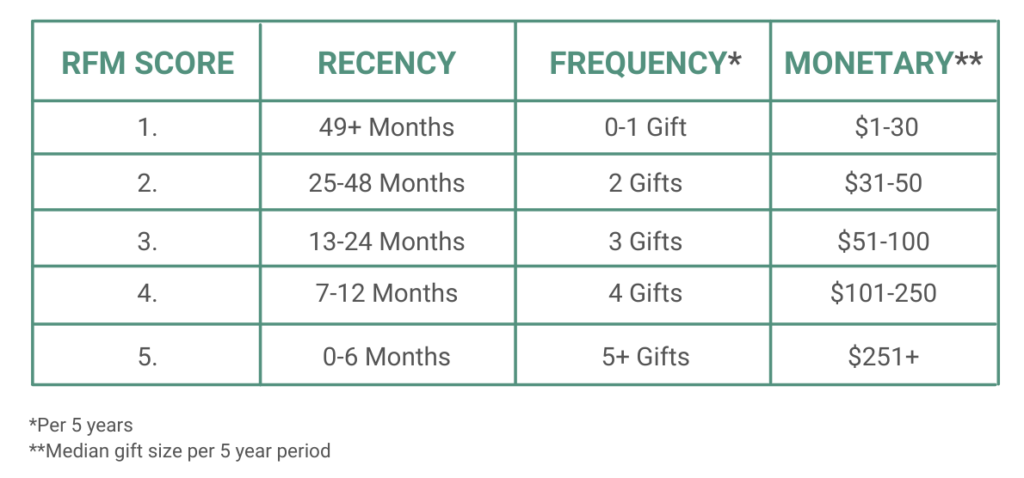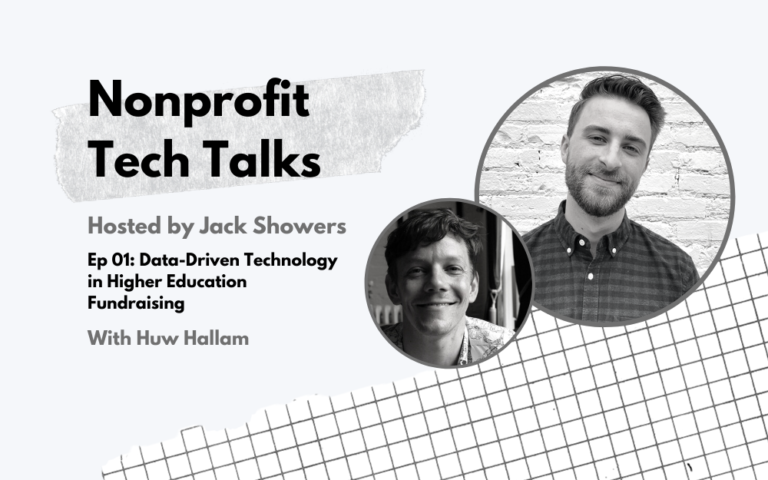Many techniques first established in the corporate world have been adopted successfully in the nonprofit sector, such as selling goods and services, analyzing stakeholder data in real-time, and investing in marketing efforts.
One such technique, the RFM segmentation model, was first adopted as a corporate marketing tool used to assess customer engagement levels. But it can provide immense value to fundraisers looking to create a deeper bond with their donors.
RFM is an abbreviation of three engagement factors: recency, frequency, and monetary. Within a nonprofit, these factors help segment donors based on engagement levels. After segments of donors have been created, each is targeted with personalized messaging designed to create a unique giving experience and yield more donations.
Additionally, your donor segments provide you with a platform for experimentation. By sending specific appeals to certain segments and monitoring engagement levels, you understand what marketing techniques do and don’t work for your nonprofit.
In the next section, I’ll describe the three RFM factors briefly. Afterward, I will outline a particular use case for RFM segmentation by exploring its application to email campaigns.
Please only use this article as a general outline for using RFM, and remember that each organization will require different engagement parameters for their various campaigns.
Ok, let’s dive in.
Start Segmenting Your Donors
Use this FREE Donor Segmentation Template to segment your donors and contacts based on their level of engagement.
What are the Dimensions of RFM Segmentation for Nonprofits?
Recency
In RFM analysis, the recency factor is the amount of time passed since a donor’s last gift.
Recency is fundamental to understanding donor engagement. For example, someone who donated last week is more likely to give again than someone who last gave five years ago.
Before calculating your donors’ recency value, you have to determine what time periods are appropriate for your nonprofit to categorize what you consider to be “recent.” I would recommend defining a “recent” donation as one that occurred within the past six months.
A six-month period is long enough to combat donor fatigue while accounting for the seasonal lull in donations following the giving season. Having too short of a period would pressure fundraisers to solicit donations too frequently, which would result in lower donation amounts and higher donor turnover.
Additionally, six months isn’t so long that it would miss opportunities to solicit gifts outside the giving season.
Experiment with your time periods and find out what works best for your organization!
Set Your RFM Behavior Criteria
You can track behaviors indirectly related to fundraising that still represent a level of engagement, like opening emails, volunteering, or donation assists. This level of analysis can provide you with a more in-depth look at your contacts but may also prompt you to focus on more irrelevant information.
Consult your fundraising strategy to understand what behaviors your organization values most.
Frequency
On top of knowing when a donor’s most recent gift was, you also need to consider how often they give; this consideration is the frequency factor.
Tracking frequency is crucial to understanding engagement. For example, if a donor has given $50 every six months for the last five years, they are obviously more engaged than a donor who gave the same amount for the first time just a month ago.
Frequency may be the factor that’s most predictive of long-term fundraising success.
Fundraising Report Card found that the sector benchmark for first-time donor retention is only 18.87%. However, the retention rate for repeat donors is 53.19%. These stats show that if you’re able to reliably improve your donors’ giving frequency, especially for second gift conversion, you can secure funds from a more committed and engaged donor base.
Keep in mind that donors committed to a strict giving schedule, like monthly donors, will not be great candidates for RFM segmentation. It’s better to deal with monthly donors as a separate segment altogether and ask them to increase their monthly amount when appropriate.
Monetary
We already know what the final factor is because it relates to the first question everyone asks when they hear about a donation: “How much?”
The monetary factor tracks the amount a donor has given.
The best way to calculate this amount is by determining a donor’s median gift size. Calculating the median will provide you with the most common amount that a donor has given while excluding large or small outlier gifts that aren’t truly representative of their giving behavior.
Keep in mind that you also need to find a reasonable time period to calculate a donor’s median gift size. As the average donor gives twice per year, I recommend calculating median gift size over five years, so you have somewhat of a sample (approx. 10 gifts) to draw from.
This period is long enough that you have actionable data but not so long that unrepresentative gifts will throw off your findings.
How to Calculate RFM: An Email Campaign Example
Now that you understand the RFM factors or you’ve skipped to this section, let’s unpack how to calculate it.
To simplify things, I’m going to demonstrate RFM segmentation within the context of an email campaign. However, RFM is appropriate for a variety of campaigns like snail mail or text to give campaigns. Generally, RFM works best when dealing with a large group of contacts, each with numerous recorded interactions. The more data, the better!
1. Rank Order Each Factor
The best way to calculate RFM manually for an email campaign is to establish five rank-ordered categories within each of the three factors. The fifth category will be the most valuable, and the first being will be the least valuable.
When looked at collectively, these ranked categories will represent the engagement levels of each donor. And, more importantly, these categories will allow you to segment donors based on their behavior.
For example, if a segment of donors has a score of 5 across all three categories, you’ll know to solicit them regularly and ask for a high amount. However, that solicitation strategy might alienate a donor who has a score of 3 across each category. Segmentation ensures you maximize the individual giving potential of each contact while providing them with a personalized experience.
I have adapted the categories below from M+R Benchmarks’ nonprofit online engagement metrics for 2021. However, these categories are merely a guide, and you should tailor your categories to your nonprofit’s definition of success.

Once you have criteria set for each factor’s categories, assign each contact with an RFM score based on their giving behavior. Once their score has been determined, create your segmented contact list.
2. Create Your Segments
Next, label your segments. I have taken the liberty of outlining four simple segments that could be useful for any organization looking to customize its solicitations.
Shining Stars: These are the most engaged donors across each factor. These donors should have 4 or 5 scores across the board which should look something like 4-4-4, 5-5-5, or 4-5-4.
Rising Star: These are newer, promising donors who’ve given recently and a large amount. So, their R and M score should be 4 or 5, and their F score should be 1 or 2. As a result, their total score will look something like 5-1-5, 5-2-4, or 4-1-4.
Shooting Star: These are star donors that may have burned up in the atmosphere some time ago. They’ll have an F and M score of 4 or 5 but an R score of only 1 or 2. So, their total score will look something like 1-5-5, 2-4-4, or 1-4-5.
Twinkling Star: These are donors who have given frequently and recently but tend to give relatively small amounts. So, they’ll have an R and F score of 4 or 5 but an M score of 1 or 2. Consequently, their total score will look something like 5-5-1, 4-4-2, or 5-4-1.
These are just four of many different segments that would benefit from personalized messaging for an email campaign. There are a variety of other segments and scores you could also include.
Please experiment with the perimeters for each segment, invent new segments, and try out different messaging to boost donation rates.
3. Create Messaging For Each Segment
Each segment I’ve created will require personalized messaging to steward them along their donor journey.
For example, the twinkling stars segment may require an email donation form that prompts them to give $40, an amount just above their range. Additionally, the star donor segment may require an email template that encourages them to sign up for monthly giving.
Start Segmenting Your Donors
Use this FREE Donor Segmentation Template to segment your donors and contacts based on their level of engagement.
Making RFM Easier With Fundraising KIT
Fundraising KIT’s data-driven toolkit automatically generates a Donor Score segment for each of your contacts.
To create a donor score, Fundraising KIT examines several factors of a donor’s giving history to determine their overall engagement level and donation value. Some of these factors include a donor’s average amount of gifts per year, the number of years a donor has contributed, and any increase in contributions in the last year.
Ultimately, Fundraising KIT simplifies the RFM process by automatically segmenting donors based on engagement level and telling you who’s most engaged and who you need to pay closer attention to.
What’s more? A recent study found that AI-driven segmentation provided 12.7% more in email campaign revenue and improved campaign ROI by 22.8% compared to manual segmentation!
Each donor has a unique relationship with your organization. However, you probably don’t have time to tailor every communication to each donor’s exact journey. But, you can get mighty close with RFM segmentation.
I hope you use this guide to create a more personalized and rewarding experience for your donors. And, if you raise more money along the way, it’s a win-win for everyone!

Talk to a fundraising expert today to learn more about how Fundraising KIT can quickly and easily help your nonprofit raise more for your cause.

Jack Showers
Nonprofit Research Analyst at KIT
When Jack isn’t cheering for the Raptors or watching an 80s action movie, he’s studying the social sector and producing content for nonprofit professionals. As a Nonprofit Research Analyst at KIT, an AI-powered insights and reporting toolkit, he is especially passionate about helping fundraisers save time and raise more money for their cause.








One Comment